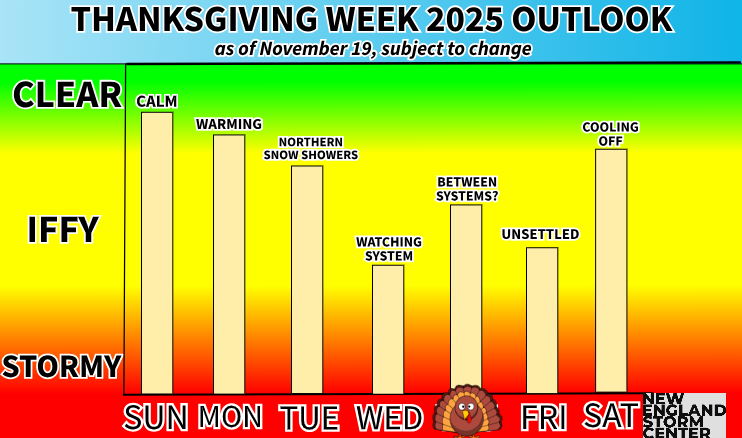Active Stretch Upcoming with Variable Temperatures for New England
- Tim Dennis
- Mar 20
- 4 min read
A wave of low pressure will scoot along a cold front Thursday into Friday. This low will form around the Mid-Atlantic and move northeast, likely passing over Cape Cod and into the Gulf of Maine. This storm has been a struggle for guidance to figure out. The system will be deepening, which will allow for cold air to be drawn down from the north after an initial surge of southerly winds.

A shield of rain will likely move into western New England in the pre-dawn hours Friday. As the secondary low tracks over Cape Cod and into the Gulf of Maine, it will draw colder air down from Canada, allowing a switch to snow showers on the backside, mainly for higher elevations of northern New England. Precipitation in southern New England will likely begin to wind down by the afternoon. Without steadier precipitation rates, the air likely won't cool enough for snowfall in southern New England, even in the higher terrain.
Below: HRRR showing potential weather in the pre-dawn hours Friday (1st image) and late-morning Friday (2nd image):
The cold front that this is happening along will slow down as it crosses New England due to the blossoming surface low pressure system. This will allow rain and northern snow to continue across much of Maine through the entire day Friday. Conditions will gradually dry out for the rest of New England from west to east during the day.
Below: HRRR showing potential weather Friday evening:

The level of deepening and the speed at which the system will be moving will ultimately determine snowfall amounts (which will be minimal no matter how it's cut). For snowfall, it will be a race between the precipitation’s end time and falling temperatures behind the front. It does appear that the precipitation's end time will win the race for most.
This will mainly be for higher terrain (over 1,000 feet) as valleys and the coastal plain look to remain too warm even with a slower solution to get anything more than maybe a few flakes mixed in. Up to an inch of snow will be most likely at or above 1,000 feet with patching coating and flakes lower. The best chance at a few inches will be within the mountains, above the level of most towns.

Yesterday, we said we had major reservations about whether the system could deepen quickly enough to initiate dynamic cooling as efficiently as guidance was showing. Dynamic cooling would be needed for snowfall given the bulk of the system would move in during the beginning of daytime heating. With that said, trends over the past 24 hours have been toward a slower development of a closed off upper-level low and weaker forcing. This will make it more difficult to get accumulating snowfall rates.
Behind the cold front, winds will shift to the northwest and strengthen. An increasingly well mixed layer will allow for gusts of 30-45mph across the region Friday afternoon and evening as the colder, drier air works into the region. Skies will gradually clear from west to east as the winds begin to pick up.
Below: Potential winds gusts late afternoon Friday:

Spring is the time of the flip-flopping temperature, and that's exactly how this spring will be kicking off. A cold front crossing on Friday will bring a cool and raw day, especially given the increasing afternoon winds. On Saturday, flow will briefly return southerly ahead of an approaching cold front. This front will cross New England later Saturday into Sunday. This will bring a cool-down for Sunday on renewed cold air advection.

That cold front on Saturday will likely spark a line of scattered rain and elevation snow showers Saturday afternoon and evening. These will be most numerous across northwest New England, with coverage decreasing as the line dries up moving east and southward. A sharp cool-down is likely behind the front, with a flash freeze possible for the northern third of New England Saturday afternoon and night.
Below: RGEM showing potential weather Saturday evening:

The next, more widespread storm system will enter New England Sunday night into Monday of next week. This system will involve a trough from the Great Lakes moving to the north of New England. A surface low may develop along the storm's triple point (where a cold, warm and occluded front meet) and rotate into New England. Depending on how the exact timing plays out, it could start as snow for many with a gradual changeover to rain as daytime heating occurs and a warm front advances northward.

The closer to the early morning the system arrives, the better the chance for some snow at the start across a wider area of the region considering that this will be the coldest part of the day. A later arrival would mean more heating and more rain over a larger area. With that said, recent trends have been toward an earlier start Monday morning. An area of high pressure over Quebec will try to lock colder air into northern New England during the day Monday, potentially delaying a changeover to rain.
This currently doesn't have the make-up of a large or powerful storm system, but some snow accumulations will be possible across northern New England and the higher elevations of southern New England. Trends with this storm could go either way (more wet or more white) at this point. It probably goes without saying at this point in the season, but any potential snow accumulations will be elevation-based
Below: Current probability of impactful winter weather Monday (March 24):








Comments